- Joined
- Sep 1, 2014
- Messages
- 12,737
- Reputation
- 4,456
- Reaction score
- 44,343
- Points
- 0
- Currently Smoking
- A vaporiser XD
[h=1]Prevention and Treatment of Bud Mold & Fusarium [/h][h=3]The increased risk of bud mold in modern varieties of cannabis
[/h][h=3]Towards the harvest season bud mold is one of the main problems that can preoccupy a grower. The high risk of several types of fungus in cannabis cultivation can however be minimized considerably, if you know what procedures during plant care are necessary, and how to properly control the environmental factors which could otherwise facilitate mold attacks. Especially during the cold and wet months of the year, from autumn to springtime, it's important to follow some basic rules in order to keep your crop safe and sound.
[/h]Some may wonder why cannabis is at all susceptible to bud mold and whether it is in principle due to the quality of breeding. The answer to this question would be a yes and no. On the one hand, a susceptibility to certain pests occurs in all species of plants, on the other hand, the natural resistance of a plant can be supported or also weakened by the breeding or cultivation method. The defence system of a plant can, for example, be weakened through consecutive breeding if the breeder is not working intensely towards preserving this trait. Unfortunately, in the cannabis seed industry the vitality and pest resistance of a strain rarely belongs to the major objectives of the breeder, so many modern varieties and hybrids show increased susceptibility to pests like Botrytis. In agriculture there are many species of plants also prone to Botrytis. More than 7000 plant species alone can be attacked by grey mold and mildew. This problem is mainly fought against in professional agriculture and horticulture by the use of strong fungicides. Most fruits, vegetables and grains are extremely susceptible to grey mold (strawberries are a common example) and without regular chemical treatments they would yield only a fraction of the current crops. Because of the health risks, it is strongly recommended to refrain from treating flowering cannabis plants with fungicides. It is already a sad fact that our food is hopelessly contaminated, and even certified organic produce continuously suffers from chemical contamination scandals in most countries.
The genetics of the plant genus Cannabis sativa/indica essentially contributes to the risk of Botrytis and other forms of mold. Any plant or animal species should be cultivated and maintained according to it's natural habitat. An orchid thrives just as poorly in the desert, as a cactus in a tropical rain forest. But we expect from cannabis botanical wonders: that it grows in almost all latitudes of the world, or even in a PC case with a feeble light source, and remains healthy and flowers wonderfully throughout. In the long-term even this does not satisfy all expectations: modern varieties of cannabis must produce more and more resin (THC), be as high yielding as possible, but also grow absolutely homogeneous.
Once we awaken from this fairy-tale it's possible to be more realistic and orientate breeding and cultivation according to the biological conditioning. It has ensured the survival of the species over thousands of years and made it one of the hardiest "weeds" in nature. If we look at heirloom (ie. landrace) strains, then we notice they are perfectly adapted to their environment and accordingly possess strong defences. It is also rare that bud mold attacks hemp grown for fibre. Only when selective breeding of certain characteristics begins, or when Cannabis sativa/indica is introduced to foreign climate zones/conditions, the greatest problems with pest infestation and weakening of a plant's defences occur. All three characteristics that many find desirable in modern cannabis strains contribute to this problem. Increased resin production, high yielding buds, and inbreeding required for true breeding homogenous strains, are major contributing factors which enhance the susceptibility of bud mold.
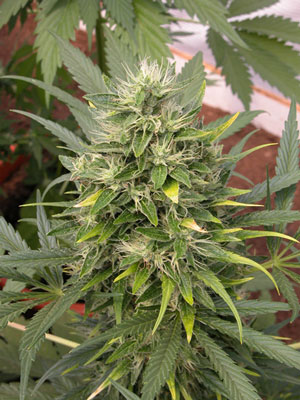
In addition, many commercially bred cannabis strains are not sufficiently adapted to the wet, cold climatic conditions they are often grown under outdoors. This genetic adaptation is a process which, depending upon climate and variety, progresses gradually and takes many years, if not decades, to complete. The result can be a variety that resembles hemp grown for fibre more than it does it's psychoactive sisters. Humans must therefore intervene in this process and control it to prevent wild adaptation and to avoid the steady reduction of medically valuable and psychoactive cannabinoids. The genetic makeup of a variety therefore calls for compromise. Somewhat less resin or yield can already be significant enough to better equip a strain against mold under critical environmental conditions - especially outdoor. Long-term and comprehensive cultivation tests facilitate the search for the perfect pairing of parental lines or strains. Careful, patient adaptation of new hybrids or pure strains can change the way they respond to new environmental conditions. Years of observation have led us to the conclusion that induced resistance is also possible towards extreme temperature fluctuations and other environmental factors. The use of landrace genetics is another way to strengthen plant defences.
Photo: a breeder must recognize plants with major weaknesses such as this specimen and have a zero-tolerance policy towards weak genetics.
In our breeding projects at Mandala Seeds the immune system and resistance of a strain belongs to one of the high priorities. We use several methods to ensure this trait is contained or enhanced in the Mandala strains:
[h=1]Making the Right Choices[/h]According to the latest scientific research the ability for humans to grow very old in good health boils down to only 20-40% of our genetic make-up. The remaining 60-80% are influenced by environmental factors: how we live and where we live. When we look at the plant world it is not much different. How we care for a plant, and to what environment we subject it to, creates the biggest impact on quality and yield (synonymous for a healthy life). As breeders it is our responsibility to ensure that the genetic base is as strong as it can be to support your efforts in proper gardening. But the primary step in preventing diseases such as bud mold is for you to also choose the right strain for your environment and cultivation style.
Some growers make very poor choices despite the highly detailed information we provide throughout our website. Carefully read the strain details for each variety, check out the Strain Guide for further details, and always consult the Outdoor Guide if you plan on cultivating outside in the garden or greenhouse. Plants are not immune to environmental factors - a point that is going to be discussed in detail in this article. At Mandala Seeds each variety is bred with specific purposes in mind. Some strains are especially bred for tropical or hot regions, others have been created for the predominantly cool north. Not every strain has been tested outdoor - and certainly not under all possible climatic conditions. Therefore, we reserve the right to periodically update strain details as new information is gathered.
Each strain not specifically bred for northern regions should only be grown in a greenhouse with some form of climate control to prevent excessive humidity and cold - provided that it is recommended for your climate in the detailed world map of the Outdoor Guide in the first place. Growers in difficult northern climates have to accept that there are only very limited choices on the cannabis seed market for truly reliable and early strains: such as Mandala #1. Even then, freak weather patterns from global warming can always threaten your crop and case unforeseen damage. Nature itself remains the ultimate force.
It is the responsibility of every grower to make intelligent decisions about the cannabis variety best suited for their climate, whether outdoor or in an artificial indoor setting. This also applies to specific indoor set-ups (such as low-light, etc.). When we state that a variety has an above average resistance to mold, fusarium, mildew, or other types of fungus and pest, this must be seen in relation to the environment for which this strain is best suited! It is completely unrealistic to expect a cannabis strain to be perfectly adapted to any or all types of climates. Especially in the northern hemisphere, or regions with a cold and wet climate, a cultivator must always firstly look at the suitability of a cannabis strain to grow and flower well under these conditions. All other desired features such as taste, bud colour, potency, or effect, are secondary criteria. If a strain is not specifically adapted to cope with cold, wet conditions and a short summer, the adverse environmental conditions are going to endanger your harvest expectations. Similarly, if a strain cannot grow in a steamy, tropical country that has a 12 hour photoperiod throughout the year, this will also lead to frustrating results. Without a decent harvest it is completely irrelevant if your strain has nice purple leaves, orange coloured buds, or a potentially wonderful taste...you can't enjoy a crop destroyed by bud mold or mildew. So the bottom line is that we offer cannabis varieties adapted to specific environments to the best of our abilities and the plant's genetic potential, but YOU are responsible for the results due to the choices you make in strain selection and plant care.
[h=1]
Guideline[/h]
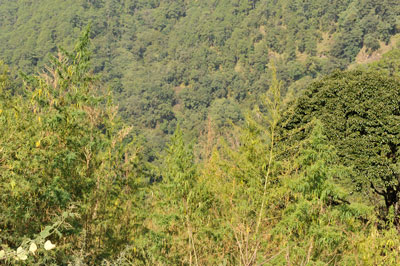
Photo: Cannabis sativa growing in the Himalayas at 2.600 meters/8,530 ft. At Mandala Seeds we preserve a large selection of finest hand-selected landrace (heirloom) seeds which are used for our breeding projects and as a gene pool for future generations.
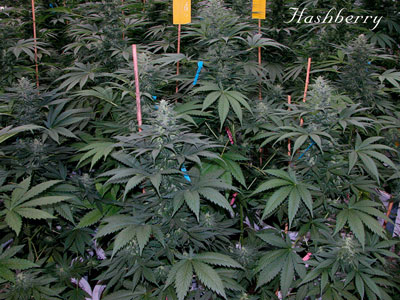
Photo: Hashberry

Photo: Sadhu
Contributing Factors
For healthy and profitable cultivation the plant care remains just as an important part as the genetics. The two photos of Hashberry and Sadhu (above) show how healthy plants should be. Healthy plants are the most important factor for a smooth and problem free cultivation. Plants are living creatures. Despite the best genetic disposition they can become sick through poor care just like people or animals do. That is why we are going to look next at the most common errors during cultivation and how they can be avoided. To start with, let's investigate some of the main causes for bud mold or grey mold (Botrytis) and stem rot (Fusarium).
[h=4]Overfeeding[/h]A high accumulation of nutrients leads to the bloating of plant tissue because the cells absorb more water. The cell walls become thinner, like a balloon being stretched, and this decreases the natural resistance of plant tissue. It becomes an easy surface for pests such as Botrytis mold to spread. Over-fertilization also leads to the premature withering of pistils in the buds. These dead pistils tend to mold easily within the humid interior of the buds and colas. A critical salt level in the substrate can also cause necrosis (burning of cell tissue) in leaves. The sick plant tissue offers an ideal breeding ground for mold spores. In this scenario, bud mold would first attack the leaf stem at the internode before spreading out towards the leaf itself – causing it to wither and die. The basic rule is not to feed more than EC 0.6-0.7 mS/cm on soil and to use moderate EC levels in hydro. Rather than trying to force-feed your plants with heroic dosages, you will get more satisfying yields and a healthier crop with mild feeding schedules. In soil cultivation feeding should be discontinued altogether during the last 2 weeks of flowering. As the plants approach senescence they gradually cease to absorb nutrients from the substrate and subsist on the stored nutrients in leaf tissue.
Feeding high levels of potassium or P/K 13-14 bud boosters during flowering rapidly leads to excess mineral salt levels in the substrate. Especially dangerous is over-fertilizing with nitrogen. Not only the use of too much liquid/granular fertilizers, but also too strongly pre-fertilized soil should be avoided. A strong nitrogen enriched fertilizer is particularly harmful when cultivating with potted soil. Too much nitrogen leads to a lot of leaf development and spindly growth. When there is an initial overabundance of nutrients, less roots grow in search for nutrients. But later, when peak flowering sets in, the root system is too underdeveloped to supply all nutrients to the plant efficiently.
Excessive nutrient supply of nitrogen leads to:
[h=4]Humidity[/h]The relative humidity plays a big role in the control or spread of mold. Levels over 50% automatically pose a danger during flowering. Most important are however the night time levels. This is a factor often overlooked or underestimated by growers. A good climate control is essential during peak and advanced flowering. The humidity should ideally lie between 25-45%. The lower the better. A min-max thermo & hydrostat is a cheap but important investment to track the climatic conditions in your grow space. Rotating fans plus constant in-and-output ventilation is important to move the air around the grow area and extract humidity. Even if the humidity levels are optimal, stagnant air can also foster mold. If a high level of humidity persists in the grow area other preventive measures are essential. These will be outlined later in the article.
[h=4]Mini-Greenhouse/Humidity Dome[/h]
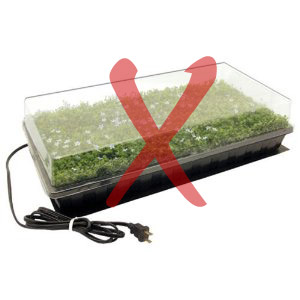 Some growers have the mistaken assumption that seedlings or clones require very high levels or humidity in the air. However, this is one of many unfortunate myths in cannabis cultivation.
Some growers have the mistaken assumption that seedlings or clones require very high levels or humidity in the air. However, this is one of many unfortunate myths in cannabis cultivation.
When using a mini-greenhouse the lid must be removed regularly and also it has to allow sufficient exchange of fresh air (ie. leave the greenhouse only partly covered). Otherwise the seedlings or clones are threatened by the fungus Fusarium which attacks the stems, or by Botrytis that can grow on small flowers situated on clones. The greenhouse should not be hermetically sealed. Remove the cover at least 1-2x daily for 1/2 hour. The relative humidity should not exceed 65%. Equally dangerous is the germination of seeds in a mini-greenhouse. Seeds or seedlings can be quickly rot in the substrate under high humidity due to the shortage of oxygen and wet conditions. Mold spores spread rapidly under these circumstances. It is important to remove the lid completely when using a greenhouse for germination or to keep it only half covered.
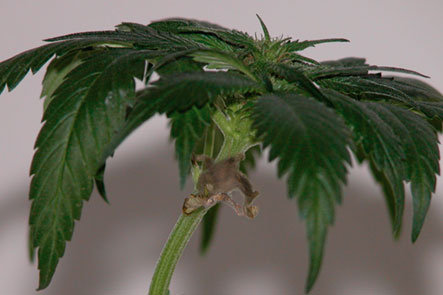 But the best method is to simply germinate in cups or trays that are large enough to prevent the soil from completely drying out in a 24-48 hr period. Similarly, for seeds in rockwool an appropriate cube size can be chosen which remains sufficiently moist. Usually, this is not a problem at all when germinating within a 25°-30°C/77°-86°F range.
But the best method is to simply germinate in cups or trays that are large enough to prevent the soil from completely drying out in a 24-48 hr period. Similarly, for seeds in rockwool an appropriate cube size can be chosen which remains sufficiently moist. Usually, this is not a problem at all when germinating within a 25°-30°C/77°-86°F range.
Photo: a clone suffering from mold due to excessive humidity & lack of ventilation in the mini-greenhouse.
[h=4] [/h]
[h=4]Over-watering
[/h]Watering correctly belongs to the most important factors in mold prevention. This means: watering the right amount and at the right time. If you grow from seed, or have a mixed garden, you should notice that plants have individual water requirements once they grow larger. This is why you should lift the pots regularly in soil cultivation to check how heavy they are and determine individual water consumption. Lifting pots is the easiest method to prevent over-watering plants. Another option is to water just enough for daily use, or for two days at the most. It not only increases the movement of oxygen to the root zone and promotes growth and healthy roots, but also prevents all types of fungus and mold.
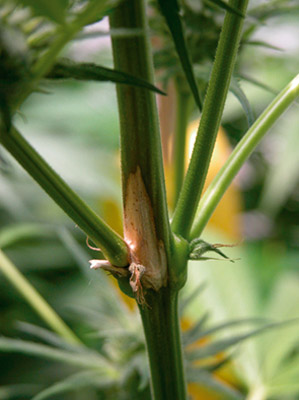
A popular method is to flush soil with large amounts of water towards harvest time. Some growers believe this is necessary to rinse out unsavoury minerals or substances which may otherwise negatively influence the flavour of the crop. Whereas flushing substrates with pure water is conducive, and indeed necessary, in hydroponics - it is quite dangerous when applied to containers filled with soil. Hydroponic substrates are very porous and drain quickly so that a high air-to-water ratio is quickly reestablished. But waterlogged soil requires days if not an entire week to dry. It drowns the root zone, thereby completely depleting it of oxygen. Anaerobic bacteria quickly spread leading to a high risk of fusarium. In the meantime, the plant absorbs a large amount of water until the tissues are bloated with water and begin to „sweat". Within the dense buds the internal humidity rises to extremely high levels, so that when you touch the interior your fingers are moist. All factors combined can trigger bud mold within hours of flushing, after which it spreads throughout the flowering colas. We have regularly observed growers reporting bud mold 1-2 days after rinsing their soil based plants. The correct approach to watering cannabis on soil during the last 2 weeks of flowering is to reduce watering as much as possible without interfering with plant health (ie. avoid thoroughly dried up pots and prolonged periods of droopy leaves on plants). Especially if high humidity persists this is one of the most secure methods to avert bud mold. Always water shortly after lights go on. For outdoor, water before noon time. The top layer of the soil should be dry by the time the dark period starts.
Photo: over-watering and soggy soil also causes Fusarium or stem rot. This condition can destroy the plant tissue of stems completely and lead to the wilting of the entire plant. If conditions improve a plant can recover from moderate symptoms such as this one. Mandala strains are less prone to Fusarium due to the strong and thick plant tissue and stems.
[h=4]Temperature
[/h]The temperature of the night cycle is a critical factor. Together with the humidity levels it has a very important influence in controlling bud mold. Botrytis thrives in a humid, cold and dark environment. The 12 hour dark cycle is necessary during flowering and cannot be changed. Which is why the other two factors must be held in check for optimal crop protection. Many equatorial strains do not mold in their natural habitat because of the high temperatures. This is why the occurrence of bud mold is less likely if it is hot and humid in your grow room or outdoor garden. But if the temperature during the night cycle falls under 64-68°F/18-20°C Botrytis has good conditions to develop. Levels around 55-60°F/12-16°C are very critical. Humidity also accumulates steadily as temperatures drop, which is why heavy fog is common once nights get colder in autumn. Thick fog is just as dangerous for outdoor crops as rain and you should make periodic checks for bud mold in such a situation. Indoor it is relatively easy to lower humidity levels by heating the grow room and running a suitable in-and-output ventilation. With a temperature controller the ventilation can be made to switch on and off once a certain temperature is reached in the grow area to maintain an optimal temperature range. The same method works for a greenhouse. Mobile butane heaters, with or without a mobile air-conditioner to extract excess humidity, are a good option for heating a closed greenhouse. Small to medium range in-output ventilators are nevertheless necessary to extract the gases from the butane heater and provide fresh air. During heavy, prolonged rain and cold spells this kind of setup should also be used during the day - otherwise humidity in a greenhouse can quickly rise to 100%.
[h=4]Pests
[/h]
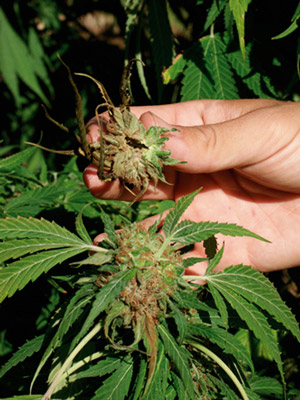
A chronic infestation of white fly and aphids promotes Botrytis and mildew. The sticky secretions deposited by the adult insects easily mold, the punctured leaf surface where they feed destroys cell tissue on which mold can spread, and the general immune resistance of the plant suffers. Spider mites and other pests also weaken plant defences and can thereby support a mold attack.
The #1 bud killer during peak flowering outdoors are caterpillars. They not only eat the buds but their trail of faeces is highly conducive for mold. Use special netting available from horticultural stores that protects against the moths and butterflies laying their eggs in the plants. Greenhouses can be protected by netting too. Make sure the entrance has an overlapping netting. We have seen moths try to get in through any crack they can find. They even wait at the side for an opportunity to slip in!
Photo: a top bud 'decapitated' by a caterpillar and signs of spreading bud mold.
Photo: horticultural netting can be life-saving for your crop, it prevents moths and butterflies injecting their eggs into the plant tissue. Eggs later hatch as caterpillars that rapidly destroy flowering buds and 'decapitate' entire stems.
[h=4]Compact buds
[/h]
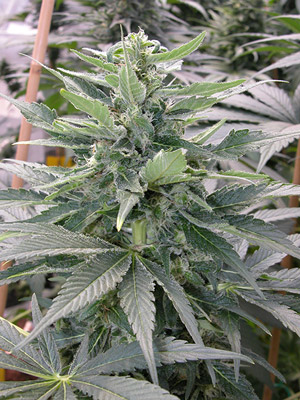
Plants with a very dense head cola may develop bud mold towards harvest time despite precautionary measures. The safest method to prevent this is to open the head cola about 10-14 days before harvest by carefully cutting out a bud in the top half. This leaves a gap where sufficient air exchange can take place to allow the otherwise trapped moisture within the head cola to escape. It is quite seldom that a head cola will still develop mold when this procedure is carried out. For this method you have to proceed carefully because the single buds in a compact cola lie directly next to the stem and it is important not to accidentally cut into it with the scissor. Make a small incision first to loosen the bud so that you can see exactly where the stem is before cutting further. Very mold susceptible strains can start to rot no matter what precautions are taken. A popular method to reduce mold risk especially outdoor is to prune/trim the top 1-3 times and grow a large bushy plant. The multiple head colas which develop on a pruned plant have a slimmer width and retain less moisture.
Photo: a bud was removed from this increasingly dense main cola as a precautionary measure during an extended period of high humidity in the grow area. This method can be very effective in preventing bud mold. It helps to think in advance.
Nonsensical methods
A variety of silly practices abound that some people have proclaimed will lead to higher yields, more resin, better taste, etc. Meaningful experiments should be differentiated from absurd ideas. Use your common sense and remember that a healthy plant and good genetics is the only guarantee for a great harvest.
With regards to mold these are some of the scenarios that can backfire:
[h=1]Controlling bud mold[/h]
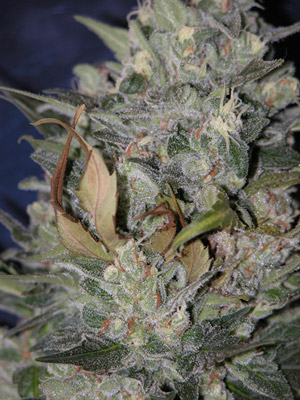 Regular controls are a prerequisite for the effective treatment of mold. Even if you don't spend much time in your garden, during peak flowering you should spend at least 20 minutes daily for a routine check on the plants. Only through early detection can a dense head cola be saved from noticeable damage or loss. Botrytis is a very aggressive type of mold that can spread overnight. Unfortunately, it frequently happens that growers do not recognize the first symptoms. This is mainly due to three reasons: lack of control during critical periods; the symptoms are overlooked because the plants are in an overall poor condition with sick leaves, etc.; lack of knowledge about the spread and prevention of mold.
Regular controls are a prerequisite for the effective treatment of mold. Even if you don't spend much time in your garden, during peak flowering you should spend at least 20 minutes daily for a routine check on the plants. Only through early detection can a dense head cola be saved from noticeable damage or loss. Botrytis is a very aggressive type of mold that can spread overnight. Unfortunately, it frequently happens that growers do not recognize the first symptoms. This is mainly due to three reasons: lack of control during critical periods; the symptoms are overlooked because the plants are in an overall poor condition with sick leaves, etc.; lack of knowledge about the spread and prevention of mold.
A clear indicator for the spread of Botrytis is the yellowing and wilting of a bud leaf in the main cola. The leaf first tends to crinkle and then dies, even if all other leaves in the vicinity look normal (see photo on the left). You can usually easily pull it out of the main bud because the mold has eaten away the leaf stem (causing the leaf to die). This typical symptom often remains unnoticed because growers think leaf yellowing is normal, or because their plants are already suffering from other symptoms such as over- and underfeeding. However, if you are giving your plants a balanced nutrient supply from growth to flowering there is no reason for them to look like 'death warmed over' prior to harvest. Also, healthy yellowing in the last stages of flowering, especially outdoor, can be differentiated from the unhealthy appearance of leaves attacked by mold. When examining your plants just focus on the bud leaves, those growing out of the densest flowers, because this is where humidity gets trapped and mold can spread.
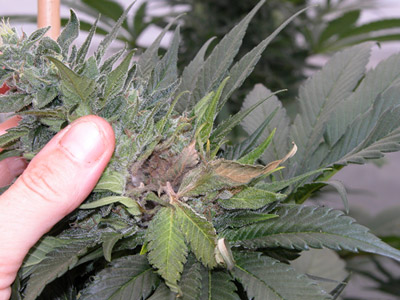
Another early indicator are greyish coloured calyxes, especially those located in the internodes of buds. These often function as a breeding ground for mold as the buds mature and grow denser. When you check head buds by gently prying them open watch out for any grey-brown discolouration, no matter how mild. Monitor these areas with regular controls if necessary.
Once mold spreads you quickly detect obvious changes in the buds. Small pockets of mold are present wherever the flowers turn greyish and fuzzy. It's quite similar to seeing bread mold. The plant tissue eventually disintegrates into a greyish slush so when you touch theses areas you can feel the wet, soft tissue give way. At this stage you have to act immediately and remove the infected buds or harvest your plant. prior to harvest. Also, healthy yellowing in the last stages of flowering, especially outdoor, can be differentiated from the unhealthy appearance of leaves attacked by mold.
When examining your plants focus on the bud leaves, those growing out of the densest flowers, because this is where humidity gets trapped and mold can spread.
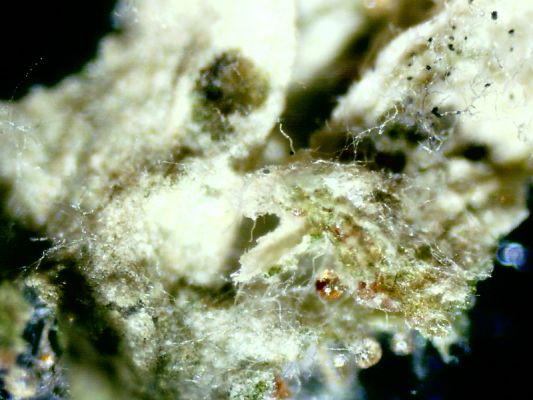
Photo: 40x microscopic enlargement of Botrytis inside a bud. Notice the decaying greyish plant tissue and the black mold spores in the top right corner.
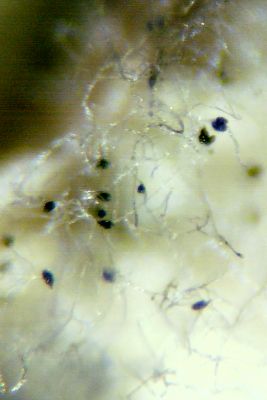
Photo: 100x microscopic enlargement of germinating Botrytis mold spores.
[h=1]Steps to undertake[/h]
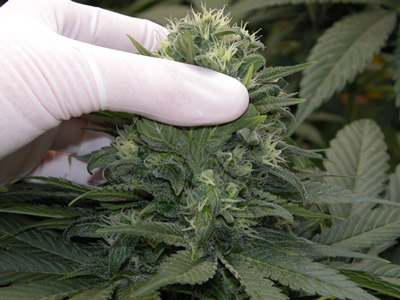
1. Use dispensable gloves to regularly check the densest areas of bud growth approx. 2 weeks prior to harvest for signs of mold. It's important not to be too squeamish about touching the buds. The gloves assist with this and are also very easy to clean with 96° alcohol before moving on to the next plant (you don't want to spread mold inadvertently from plant to plant!). Don't worry about some of the resin rubbing off. The vast majority of resin is inside the buds and resin is also replenished.
Photo: use a bud leaf to protect the calyxes and gently hold back the main cola to get a view inside. Don’t grab it with force! Be careful - all you want is to see if the main stem and inner bud area is healthy.
2. If the main cola is super-dense use the method of carefully "opening" the cola by removing a bud in the top half of the main stem. This allows air exchange and facilitates the removal of humidity in the cola.
3. When a small area of bud mold is detected you can try to treat this with rubbing alcohol after removing the infected flower and leaf material. Put a small amount of alcohol on cotton wool and dab the stem and surrounding area with it. This will dry out from the alcohol and kill all mold spores. If the environmental conditions are good the light and fresh air passing through this previously infected area will prevent further spread of mold in the near vicinity.
4. Always remove infected buds and leaves from a plant immediately and do not throw infected plant material in a bin near your grow area or on the ground.
5. If a plant has an advanced mold problem you must remove it completely from the grow area to protect your remaining plants.
6. The following factors should be checked and controlled:
7. Don't ignore yellowing bud leaves. In dense buds this is the #1 telltale sign of bud mold.
8. Rotate your plants if your grow space does not spread light equally. Darker areas are more prone to bud mold. Similarly, check your grow space for corners with higher levels of humidity or colder temperature by moving the hydro-thermostat around the room. Arrange the position of the plants and your heating/fan equipment accordingly.
[h=1]Biological Plant Products[/h]The following products must be used prophylactically. They are ineffective when applied once mold has spread. We do not guarantee the efficacy of any products purchased*.
* Mandala Seeds shall not be responsible for the use of any information herein presented and you must make your own decision as to its suitability and completeness for your use. We are not responsible for the use of a product mentioned and any effects or consequences it may have on your cultivation.
Rock Dust
Rock dust is mostly produced from volcanic rock and contains many minerals, trace elements and silica. The high silicon content helps against fungi and other pests. The 100+ minerals and elements further strengthen the plant and enhance health, yield, aroma.
Liverwort Extract
Bryophytes belong to the group of the oldest known land plants are on our planet since 350 million years. One of the features that helped bryophytes to survive and maintain their place in today’s flora is their content of biologically active compounds. These protect the usually delicate plants not only from fungi and other micro-organisms but also from insects and slugs, which are common dangers in the bryophytes’ habitats. In a way the biochemical compounds take the place of higher plants’ thick cuticle and bark. In some ethnic groups the fungicidal and bactericidal effect of bryophytes has been known from time immemorial. North-American Indians used mosses to treat burns and open wounds. Chinese traditional medicine names 40 kinds of bryophytes, that were used to treat illnesses.
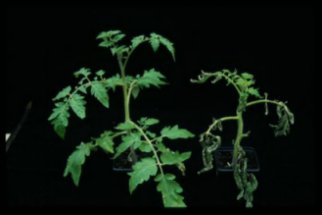 Effect of entire liverwort extract on tomato plant infected with Phytophtora infestans.
Effect of entire liverwort extract on tomato plant infected with Phytophtora infestans.
Left: treated with extract. Right: without extract. Photo & info courtesy of Uni Bonn.
The Phytopathological Institute in Bonn, Germany was the first to test Liverwort extract. Green house tests showed that plants (tomato, pepper, cucumber, wheat) treated with liverwort extract were distinctly less affected (if at all) by fungus than untreated plants. Interestingly the efficacy was noticeably higher than that of commercial fungicides.
BIORepell/ENVI-Repel
ENVIRepel Garlic Concentrate is a 100% natural herb extract from Garlic. Contains significant amounts of iron, organic Selenium and other important micro-nutrients. Conventional chemical pesticides coat the leaf surface and kill pests on contact or after the insect has attacked the plant. ENVIRepel works differently: it is absorbed by the plant and changes the chemistry of the foliage. This causes a shift in the emitted radiation spectrum or more simply scientific: the ’smell’ of the plant. Insects, which are genetically coded to find their food by scent, do not ’find’ the plants anymore. The well-known anti-bacterial and antibiotic effects of the garlic prevents many infectious diseases such as mildew and grey mold.
ENVIRepel is a unique natural repellent and feeding depressant as well as a foliar feed. Especially when applied together with foliar feeds and/or biostimulants like liquid seaweed it has a dramatic effect on the plants performance.
Disclaimer: we do not guarantee the efficacy of any products mentioned in this article. Customers using any products do so at their own risk. We are not responsible for any damages or problems that may occur in connection with the statements made in this article or the products mentioned.
copied & pasted from Mandala Seeds - http://www.mandalaseeds.com/Guides/Preventing-Bud-Mold
[/h][h=3]Towards the harvest season bud mold is one of the main problems that can preoccupy a grower. The high risk of several types of fungus in cannabis cultivation can however be minimized considerably, if you know what procedures during plant care are necessary, and how to properly control the environmental factors which could otherwise facilitate mold attacks. Especially during the cold and wet months of the year, from autumn to springtime, it's important to follow some basic rules in order to keep your crop safe and sound.
[/h]Some may wonder why cannabis is at all susceptible to bud mold and whether it is in principle due to the quality of breeding. The answer to this question would be a yes and no. On the one hand, a susceptibility to certain pests occurs in all species of plants, on the other hand, the natural resistance of a plant can be supported or also weakened by the breeding or cultivation method. The defence system of a plant can, for example, be weakened through consecutive breeding if the breeder is not working intensely towards preserving this trait. Unfortunately, in the cannabis seed industry the vitality and pest resistance of a strain rarely belongs to the major objectives of the breeder, so many modern varieties and hybrids show increased susceptibility to pests like Botrytis. In agriculture there are many species of plants also prone to Botrytis. More than 7000 plant species alone can be attacked by grey mold and mildew. This problem is mainly fought against in professional agriculture and horticulture by the use of strong fungicides. Most fruits, vegetables and grains are extremely susceptible to grey mold (strawberries are a common example) and without regular chemical treatments they would yield only a fraction of the current crops. Because of the health risks, it is strongly recommended to refrain from treating flowering cannabis plants with fungicides. It is already a sad fact that our food is hopelessly contaminated, and even certified organic produce continuously suffers from chemical contamination scandals in most countries.
The genetics of the plant genus Cannabis sativa/indica essentially contributes to the risk of Botrytis and other forms of mold. Any plant or animal species should be cultivated and maintained according to it's natural habitat. An orchid thrives just as poorly in the desert, as a cactus in a tropical rain forest. But we expect from cannabis botanical wonders: that it grows in almost all latitudes of the world, or even in a PC case with a feeble light source, and remains healthy and flowers wonderfully throughout. In the long-term even this does not satisfy all expectations: modern varieties of cannabis must produce more and more resin (THC), be as high yielding as possible, but also grow absolutely homogeneous.
Once we awaken from this fairy-tale it's possible to be more realistic and orientate breeding and cultivation according to the biological conditioning. It has ensured the survival of the species over thousands of years and made it one of the hardiest "weeds" in nature. If we look at heirloom (ie. landrace) strains, then we notice they are perfectly adapted to their environment and accordingly possess strong defences. It is also rare that bud mold attacks hemp grown for fibre. Only when selective breeding of certain characteristics begins, or when Cannabis sativa/indica is introduced to foreign climate zones/conditions, the greatest problems with pest infestation and weakening of a plant's defences occur. All three characteristics that many find desirable in modern cannabis strains contribute to this problem. Increased resin production, high yielding buds, and inbreeding required for true breeding homogenous strains, are major contributing factors which enhance the susceptibility of bud mold.

In addition, many commercially bred cannabis strains are not sufficiently adapted to the wet, cold climatic conditions they are often grown under outdoors. This genetic adaptation is a process which, depending upon climate and variety, progresses gradually and takes many years, if not decades, to complete. The result can be a variety that resembles hemp grown for fibre more than it does it's psychoactive sisters. Humans must therefore intervene in this process and control it to prevent wild adaptation and to avoid the steady reduction of medically valuable and psychoactive cannabinoids. The genetic makeup of a variety therefore calls for compromise. Somewhat less resin or yield can already be significant enough to better equip a strain against mold under critical environmental conditions - especially outdoor. Long-term and comprehensive cultivation tests facilitate the search for the perfect pairing of parental lines or strains. Careful, patient adaptation of new hybrids or pure strains can change the way they respond to new environmental conditions. Years of observation have led us to the conclusion that induced resistance is also possible towards extreme temperature fluctuations and other environmental factors. The use of landrace genetics is another way to strengthen plant defences.
Photo: a breeder must recognize plants with major weaknesses such as this specimen and have a zero-tolerance policy towards weak genetics.
In our breeding projects at Mandala Seeds the immune system and resistance of a strain belongs to one of the high priorities. We use several methods to ensure this trait is contained or enhanced in the Mandala strains:
- large-scale and strict selection of plants in parental lines
- reinforcement with specific genetic strengths of landrace varieties
- creating varieties with a heterosis effect so that they have vitality, stronger plant tissue, and increased defences (ie. resistance against pests, temperature fluctuations, wind, light stress, etc.)
- breeding under intense grow conditions that enforce the survival capabilities of the plants
- methods of plant care with the objective of supporting systemic acquired resistance (SAR), which is a "whole-plant" resistance response that occurs following an earlier localized exposure to pathogens
- Hashberry
- Kalichakra
- Beyond the Brain
- Point of No Return
- Speed Queen
- Mandala #1
- 8 Miles High
- Krystalica (phenotype A-high)
- Satori (especially outdoor)
- Far Out
- White Bhutanese (outdoor strain only)
- Purple Paro Valley (outdoor strain only)
- White Magic (outdoor strain only)
[h=1]Making the Right Choices[/h]According to the latest scientific research the ability for humans to grow very old in good health boils down to only 20-40% of our genetic make-up. The remaining 60-80% are influenced by environmental factors: how we live and where we live. When we look at the plant world it is not much different. How we care for a plant, and to what environment we subject it to, creates the biggest impact on quality and yield (synonymous for a healthy life). As breeders it is our responsibility to ensure that the genetic base is as strong as it can be to support your efforts in proper gardening. But the primary step in preventing diseases such as bud mold is for you to also choose the right strain for your environment and cultivation style.
Some growers make very poor choices despite the highly detailed information we provide throughout our website. Carefully read the strain details for each variety, check out the Strain Guide for further details, and always consult the Outdoor Guide if you plan on cultivating outside in the garden or greenhouse. Plants are not immune to environmental factors - a point that is going to be discussed in detail in this article. At Mandala Seeds each variety is bred with specific purposes in mind. Some strains are especially bred for tropical or hot regions, others have been created for the predominantly cool north. Not every strain has been tested outdoor - and certainly not under all possible climatic conditions. Therefore, we reserve the right to periodically update strain details as new information is gathered.
Each strain not specifically bred for northern regions should only be grown in a greenhouse with some form of climate control to prevent excessive humidity and cold - provided that it is recommended for your climate in the detailed world map of the Outdoor Guide in the first place. Growers in difficult northern climates have to accept that there are only very limited choices on the cannabis seed market for truly reliable and early strains: such as Mandala #1. Even then, freak weather patterns from global warming can always threaten your crop and case unforeseen damage. Nature itself remains the ultimate force.
It is the responsibility of every grower to make intelligent decisions about the cannabis variety best suited for their climate, whether outdoor or in an artificial indoor setting. This also applies to specific indoor set-ups (such as low-light, etc.). When we state that a variety has an above average resistance to mold, fusarium, mildew, or other types of fungus and pest, this must be seen in relation to the environment for which this strain is best suited! It is completely unrealistic to expect a cannabis strain to be perfectly adapted to any or all types of climates. Especially in the northern hemisphere, or regions with a cold and wet climate, a cultivator must always firstly look at the suitability of a cannabis strain to grow and flower well under these conditions. All other desired features such as taste, bud colour, potency, or effect, are secondary criteria. If a strain is not specifically adapted to cope with cold, wet conditions and a short summer, the adverse environmental conditions are going to endanger your harvest expectations. Similarly, if a strain cannot grow in a steamy, tropical country that has a 12 hour photoperiod throughout the year, this will also lead to frustrating results. Without a decent harvest it is completely irrelevant if your strain has nice purple leaves, orange coloured buds, or a potentially wonderful taste...you can't enjoy a crop destroyed by bud mold or mildew. So the bottom line is that we offer cannabis varieties adapted to specific environments to the best of our abilities and the plant's genetic potential, but YOU are responsible for the results due to the choices you make in strain selection and plant care.
[h=1]
Guideline[/h]
- Consult the Outdoor Guide to find the strain(s) specifically recommended for your region and look at the mold & pest resistance chart.
- For outdoor always select a strain according to the climatic conditions first, other features are secondary.
- Carefully read the strain details in our online catalogue for additional info on mold resistance and climate recommendations.
- It is better to grow less varieties that are best adapted for your climate, rather than choosing many strains which can pose a high risk. Mold is highly contagious!
- Experiment with a strain that sounds promising in case you are uncertain. You can always grow it again the next season on a larger scale if you are satisfied.
- Take cuttings from selected females as back-up's for potential mother plants. There are always outstanding plants/phenotypes in a sufficiently large population that show higher resistance to diseases or pests common in your area. These can become valuable mother plants for many years under proper care.

Photo: Cannabis sativa growing in the Himalayas at 2.600 meters/8,530 ft. At Mandala Seeds we preserve a large selection of finest hand-selected landrace (heirloom) seeds which are used for our breeding projects and as a gene pool for future generations.

Photo: Hashberry

Photo: Sadhu
Contributing Factors
For healthy and profitable cultivation the plant care remains just as an important part as the genetics. The two photos of Hashberry and Sadhu (above) show how healthy plants should be. Healthy plants are the most important factor for a smooth and problem free cultivation. Plants are living creatures. Despite the best genetic disposition they can become sick through poor care just like people or animals do. That is why we are going to look next at the most common errors during cultivation and how they can be avoided. To start with, let's investigate some of the main causes for bud mold or grey mold (Botrytis) and stem rot (Fusarium).
[h=4]Overfeeding[/h]A high accumulation of nutrients leads to the bloating of plant tissue because the cells absorb more water. The cell walls become thinner, like a balloon being stretched, and this decreases the natural resistance of plant tissue. It becomes an easy surface for pests such as Botrytis mold to spread. Over-fertilization also leads to the premature withering of pistils in the buds. These dead pistils tend to mold easily within the humid interior of the buds and colas. A critical salt level in the substrate can also cause necrosis (burning of cell tissue) in leaves. The sick plant tissue offers an ideal breeding ground for mold spores. In this scenario, bud mold would first attack the leaf stem at the internode before spreading out towards the leaf itself – causing it to wither and die. The basic rule is not to feed more than EC 0.6-0.7 mS/cm on soil and to use moderate EC levels in hydro. Rather than trying to force-feed your plants with heroic dosages, you will get more satisfying yields and a healthier crop with mild feeding schedules. In soil cultivation feeding should be discontinued altogether during the last 2 weeks of flowering. As the plants approach senescence they gradually cease to absorb nutrients from the substrate and subsist on the stored nutrients in leaf tissue.
Feeding high levels of potassium or P/K 13-14 bud boosters during flowering rapidly leads to excess mineral salt levels in the substrate. Especially dangerous is over-fertilizing with nitrogen. Not only the use of too much liquid/granular fertilizers, but also too strongly pre-fertilized soil should be avoided. A strong nitrogen enriched fertilizer is particularly harmful when cultivating with potted soil. Too much nitrogen leads to a lot of leaf development and spindly growth. When there is an initial overabundance of nutrients, less roots grow in search for nutrients. But later, when peak flowering sets in, the root system is too underdeveloped to supply all nutrients to the plant efficiently.
Excessive nutrient supply of nitrogen leads to:
- overly vegetative growth with reduced bud development and low resin production
- increased susceptibility to pests and fungal diseases because the accelerated growth of shoots and leaves leads to soft plant tissue
- rapid damage from frost
- enrichment of nutrients in the soil with the result of unbalanced nutrient ratios or multi-nutrient blockage
due to unbalanced pH
[h=4]Humidity[/h]The relative humidity plays a big role in the control or spread of mold. Levels over 50% automatically pose a danger during flowering. Most important are however the night time levels. This is a factor often overlooked or underestimated by growers. A good climate control is essential during peak and advanced flowering. The humidity should ideally lie between 25-45%. The lower the better. A min-max thermo & hydrostat is a cheap but important investment to track the climatic conditions in your grow space. Rotating fans plus constant in-and-output ventilation is important to move the air around the grow area and extract humidity. Even if the humidity levels are optimal, stagnant air can also foster mold. If a high level of humidity persists in the grow area other preventive measures are essential. These will be outlined later in the article.
[h=4]Mini-Greenhouse/Humidity Dome[/h]

When using a mini-greenhouse the lid must be removed regularly and also it has to allow sufficient exchange of fresh air (ie. leave the greenhouse only partly covered). Otherwise the seedlings or clones are threatened by the fungus Fusarium which attacks the stems, or by Botrytis that can grow on small flowers situated on clones. The greenhouse should not be hermetically sealed. Remove the cover at least 1-2x daily for 1/2 hour. The relative humidity should not exceed 65%. Equally dangerous is the germination of seeds in a mini-greenhouse. Seeds or seedlings can be quickly rot in the substrate under high humidity due to the shortage of oxygen and wet conditions. Mold spores spread rapidly under these circumstances. It is important to remove the lid completely when using a greenhouse for germination or to keep it only half covered.

Photo: a clone suffering from mold due to excessive humidity & lack of ventilation in the mini-greenhouse.
[h=4] [/h]
[h=4]Over-watering
[/h]Watering correctly belongs to the most important factors in mold prevention. This means: watering the right amount and at the right time. If you grow from seed, or have a mixed garden, you should notice that plants have individual water requirements once they grow larger. This is why you should lift the pots regularly in soil cultivation to check how heavy they are and determine individual water consumption. Lifting pots is the easiest method to prevent over-watering plants. Another option is to water just enough for daily use, or for two days at the most. It not only increases the movement of oxygen to the root zone and promotes growth and healthy roots, but also prevents all types of fungus and mold.

A popular method is to flush soil with large amounts of water towards harvest time. Some growers believe this is necessary to rinse out unsavoury minerals or substances which may otherwise negatively influence the flavour of the crop. Whereas flushing substrates with pure water is conducive, and indeed necessary, in hydroponics - it is quite dangerous when applied to containers filled with soil. Hydroponic substrates are very porous and drain quickly so that a high air-to-water ratio is quickly reestablished. But waterlogged soil requires days if not an entire week to dry. It drowns the root zone, thereby completely depleting it of oxygen. Anaerobic bacteria quickly spread leading to a high risk of fusarium. In the meantime, the plant absorbs a large amount of water until the tissues are bloated with water and begin to „sweat". Within the dense buds the internal humidity rises to extremely high levels, so that when you touch the interior your fingers are moist. All factors combined can trigger bud mold within hours of flushing, after which it spreads throughout the flowering colas. We have regularly observed growers reporting bud mold 1-2 days after rinsing their soil based plants. The correct approach to watering cannabis on soil during the last 2 weeks of flowering is to reduce watering as much as possible without interfering with plant health (ie. avoid thoroughly dried up pots and prolonged periods of droopy leaves on plants). Especially if high humidity persists this is one of the most secure methods to avert bud mold. Always water shortly after lights go on. For outdoor, water before noon time. The top layer of the soil should be dry by the time the dark period starts.
Photo: over-watering and soggy soil also causes Fusarium or stem rot. This condition can destroy the plant tissue of stems completely and lead to the wilting of the entire plant. If conditions improve a plant can recover from moderate symptoms such as this one. Mandala strains are less prone to Fusarium due to the strong and thick plant tissue and stems.
[h=4]Temperature
[/h]The temperature of the night cycle is a critical factor. Together with the humidity levels it has a very important influence in controlling bud mold. Botrytis thrives in a humid, cold and dark environment. The 12 hour dark cycle is necessary during flowering and cannot be changed. Which is why the other two factors must be held in check for optimal crop protection. Many equatorial strains do not mold in their natural habitat because of the high temperatures. This is why the occurrence of bud mold is less likely if it is hot and humid in your grow room or outdoor garden. But if the temperature during the night cycle falls under 64-68°F/18-20°C Botrytis has good conditions to develop. Levels around 55-60°F/12-16°C are very critical. Humidity also accumulates steadily as temperatures drop, which is why heavy fog is common once nights get colder in autumn. Thick fog is just as dangerous for outdoor crops as rain and you should make periodic checks for bud mold in such a situation. Indoor it is relatively easy to lower humidity levels by heating the grow room and running a suitable in-and-output ventilation. With a temperature controller the ventilation can be made to switch on and off once a certain temperature is reached in the grow area to maintain an optimal temperature range. The same method works for a greenhouse. Mobile butane heaters, with or without a mobile air-conditioner to extract excess humidity, are a good option for heating a closed greenhouse. Small to medium range in-output ventilators are nevertheless necessary to extract the gases from the butane heater and provide fresh air. During heavy, prolonged rain and cold spells this kind of setup should also be used during the day - otherwise humidity in a greenhouse can quickly rise to 100%.
[h=4]Pests
[/h]

A chronic infestation of white fly and aphids promotes Botrytis and mildew. The sticky secretions deposited by the adult insects easily mold, the punctured leaf surface where they feed destroys cell tissue on which mold can spread, and the general immune resistance of the plant suffers. Spider mites and other pests also weaken plant defences and can thereby support a mold attack.
The #1 bud killer during peak flowering outdoors are caterpillars. They not only eat the buds but their trail of faeces is highly conducive for mold. Use special netting available from horticultural stores that protects against the moths and butterflies laying their eggs in the plants. Greenhouses can be protected by netting too. Make sure the entrance has an overlapping netting. We have seen moths try to get in through any crack they can find. They even wait at the side for an opportunity to slip in!
Photo: a top bud 'decapitated' by a caterpillar and signs of spreading bud mold.
Photo: horticultural netting can be life-saving for your crop, it prevents moths and butterflies injecting their eggs into the plant tissue. Eggs later hatch as caterpillars that rapidly destroy flowering buds and 'decapitate' entire stems.
[h=4]Compact buds
[/h]

Plants with a very dense head cola may develop bud mold towards harvest time despite precautionary measures. The safest method to prevent this is to open the head cola about 10-14 days before harvest by carefully cutting out a bud in the top half. This leaves a gap where sufficient air exchange can take place to allow the otherwise trapped moisture within the head cola to escape. It is quite seldom that a head cola will still develop mold when this procedure is carried out. For this method you have to proceed carefully because the single buds in a compact cola lie directly next to the stem and it is important not to accidentally cut into it with the scissor. Make a small incision first to loosen the bud so that you can see exactly where the stem is before cutting further. Very mold susceptible strains can start to rot no matter what precautions are taken. A popular method to reduce mold risk especially outdoor is to prune/trim the top 1-3 times and grow a large bushy plant. The multiple head colas which develop on a pruned plant have a slimmer width and retain less moisture.
Photo: a bud was removed from this increasingly dense main cola as a precautionary measure during an extended period of high humidity in the grow area. This method can be very effective in preventing bud mold. It helps to think in advance.
Nonsensical methods
A variety of silly practices abound that some people have proclaimed will lead to higher yields, more resin, better taste, etc. Meaningful experiments should be differentiated from absurd ideas. Use your common sense and remember that a healthy plant and good genetics is the only guarantee for a great harvest.
With regards to mold these are some of the scenarios that can backfire:
- leaving your ripening crop in the dark for several days
- flushing your potted soil with big amounts of water
- feeding your flowering plants with fish emulsion, guano, and other nitrogen potent fertilizer
- hanging your harvested plants untrimmed & upside down to dry slowly (often in a dimly lit room)
- spraying organic teas, pesticides, bud boosters, etc. on buds
- wrapping harvested shoots in newspaper to dry
- covering top layer of soil with organic residues, guano, mulch, etc.
[h=1]Controlling bud mold[/h]

A clear indicator for the spread of Botrytis is the yellowing and wilting of a bud leaf in the main cola. The leaf first tends to crinkle and then dies, even if all other leaves in the vicinity look normal (see photo on the left). You can usually easily pull it out of the main bud because the mold has eaten away the leaf stem (causing the leaf to die). This typical symptom often remains unnoticed because growers think leaf yellowing is normal, or because their plants are already suffering from other symptoms such as over- and underfeeding. However, if you are giving your plants a balanced nutrient supply from growth to flowering there is no reason for them to look like 'death warmed over' prior to harvest. Also, healthy yellowing in the last stages of flowering, especially outdoor, can be differentiated from the unhealthy appearance of leaves attacked by mold. When examining your plants just focus on the bud leaves, those growing out of the densest flowers, because this is where humidity gets trapped and mold can spread.

Another early indicator are greyish coloured calyxes, especially those located in the internodes of buds. These often function as a breeding ground for mold as the buds mature and grow denser. When you check head buds by gently prying them open watch out for any grey-brown discolouration, no matter how mild. Monitor these areas with regular controls if necessary.
Once mold spreads you quickly detect obvious changes in the buds. Small pockets of mold are present wherever the flowers turn greyish and fuzzy. It's quite similar to seeing bread mold. The plant tissue eventually disintegrates into a greyish slush so when you touch theses areas you can feel the wet, soft tissue give way. At this stage you have to act immediately and remove the infected buds or harvest your plant. prior to harvest. Also, healthy yellowing in the last stages of flowering, especially outdoor, can be differentiated from the unhealthy appearance of leaves attacked by mold.
When examining your plants focus on the bud leaves, those growing out of the densest flowers, because this is where humidity gets trapped and mold can spread.

Photo: 40x microscopic enlargement of Botrytis inside a bud. Notice the decaying greyish plant tissue and the black mold spores in the top right corner.

Photo: 100x microscopic enlargement of germinating Botrytis mold spores.
[h=1]Steps to undertake[/h]

1. Use dispensable gloves to regularly check the densest areas of bud growth approx. 2 weeks prior to harvest for signs of mold. It's important not to be too squeamish about touching the buds. The gloves assist with this and are also very easy to clean with 96° alcohol before moving on to the next plant (you don't want to spread mold inadvertently from plant to plant!). Don't worry about some of the resin rubbing off. The vast majority of resin is inside the buds and resin is also replenished.
Photo: use a bud leaf to protect the calyxes and gently hold back the main cola to get a view inside. Don’t grab it with force! Be careful - all you want is to see if the main stem and inner bud area is healthy.
2. If the main cola is super-dense use the method of carefully "opening" the cola by removing a bud in the top half of the main stem. This allows air exchange and facilitates the removal of humidity in the cola.
3. When a small area of bud mold is detected you can try to treat this with rubbing alcohol after removing the infected flower and leaf material. Put a small amount of alcohol on cotton wool and dab the stem and surrounding area with it. This will dry out from the alcohol and kill all mold spores. If the environmental conditions are good the light and fresh air passing through this previously infected area will prevent further spread of mold in the near vicinity.
4. Always remove infected buds and leaves from a plant immediately and do not throw infected plant material in a bin near your grow area or on the ground.
5. If a plant has an advanced mold problem you must remove it completely from the grow area to protect your remaining plants.
6. The following factors should be checked and controlled:
- Humidity
- Night time temperature
- Watering amount
- EC/ppm and pH level for hydroponics
- pH of water for soil cultivation
- EC/ppm of nutrient solution if fertilizing on soil
7. Don't ignore yellowing bud leaves. In dense buds this is the #1 telltale sign of bud mold.
8. Rotate your plants if your grow space does not spread light equally. Darker areas are more prone to bud mold. Similarly, check your grow space for corners with higher levels of humidity or colder temperature by moving the hydro-thermostat around the room. Arrange the position of the plants and your heating/fan equipment accordingly.
[h=1]Biological Plant Products[/h]The following products must be used prophylactically. They are ineffective when applied once mold has spread. We do not guarantee the efficacy of any products purchased*.
* Mandala Seeds shall not be responsible for the use of any information herein presented and you must make your own decision as to its suitability and completeness for your use. We are not responsible for the use of a product mentioned and any effects or consequences it may have on your cultivation.
Rock Dust
Rock dust is mostly produced from volcanic rock and contains many minerals, trace elements and silica. The high silicon content helps against fungi and other pests. The 100+ minerals and elements further strengthen the plant and enhance health, yield, aroma.
Liverwort Extract
Bryophytes belong to the group of the oldest known land plants are on our planet since 350 million years. One of the features that helped bryophytes to survive and maintain their place in today’s flora is their content of biologically active compounds. These protect the usually delicate plants not only from fungi and other micro-organisms but also from insects and slugs, which are common dangers in the bryophytes’ habitats. In a way the biochemical compounds take the place of higher plants’ thick cuticle and bark. In some ethnic groups the fungicidal and bactericidal effect of bryophytes has been known from time immemorial. North-American Indians used mosses to treat burns and open wounds. Chinese traditional medicine names 40 kinds of bryophytes, that were used to treat illnesses.

Left: treated with extract. Right: without extract. Photo & info courtesy of Uni Bonn.
The Phytopathological Institute in Bonn, Germany was the first to test Liverwort extract. Green house tests showed that plants (tomato, pepper, cucumber, wheat) treated with liverwort extract were distinctly less affected (if at all) by fungus than untreated plants. Interestingly the efficacy was noticeably higher than that of commercial fungicides.
BIORepell/ENVI-Repel
ENVIRepel Garlic Concentrate is a 100% natural herb extract from Garlic. Contains significant amounts of iron, organic Selenium and other important micro-nutrients. Conventional chemical pesticides coat the leaf surface and kill pests on contact or after the insect has attacked the plant. ENVIRepel works differently: it is absorbed by the plant and changes the chemistry of the foliage. This causes a shift in the emitted radiation spectrum or more simply scientific: the ’smell’ of the plant. Insects, which are genetically coded to find their food by scent, do not ’find’ the plants anymore. The well-known anti-bacterial and antibiotic effects of the garlic prevents many infectious diseases such as mildew and grey mold.
ENVIRepel is a unique natural repellent and feeding depressant as well as a foliar feed. Especially when applied together with foliar feeds and/or biostimulants like liquid seaweed it has a dramatic effect on the plants performance.
- Pests avoid plants for approx. 2 weeks because of smell
- Disrupts food instinct and reproduction of pests
- Harmless to beneficial insects
- Antibacterial action lessens risk of fungal infection
- Increased chlorophyll production results in healthier plants and better crops
- Can be used on sensitive plants
Disclaimer: we do not guarantee the efficacy of any products mentioned in this article. Customers using any products do so at their own risk. We are not responsible for any damages or problems that may occur in connection with the statements made in this article or the products mentioned.
copied & pasted from Mandala Seeds - http://www.mandalaseeds.com/Guides/Preventing-Bud-Mold
